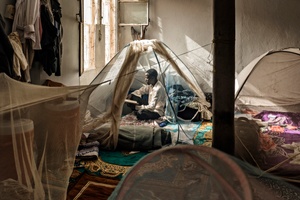KVOST Stipendium & Claus Michaletz Preis 2024
In the organizer's words:
Borderland: Where do national and cultural identities begin and end? At what point do official and private histories overlap? What is visible and what remains hidden from view?
The starting point for Magdalena Ciemierkiewicz's works shown at KVOST is her home village of Koniaczów, located in the south-eastern corner of Poland, a historically multi-ethnic and multi-religious populated area close to the Ukrainian border.
After the end of the Second World War, the Ukrainian villagers, where Ciemierkiewicz's grandmother had grown up, were forcibly expelled by the communist government during Operation Vistula and their houses were set on fire. Since the beginning of Russia's attack on Ukraine, Ukrainians have once again been forced to flee to this region.
"I deliberately tell the story of my village from the perspective of the third generation," explains Ciemierkiewicz. "I want to show how generational wounds are still being perpetuated today, especially in the periphery, where the past needs to be dealt with even more urgently than in the big cities. I see my work as part of a new culture of remembrance."
Some of the works on display reinterpret ethnographic artifacts from the former Ukrainian Stryvihor Museum. Founded in 1932 in Przemyśl, just a stone's throw from her village, the museum contained the most extensive collection of marginalized Ukrainian folk art in the region. During the Soviet occupation, some of the objects were stolen, the rest went to the National Museum in Przemyśl after 1945, where the objects were stored and are still not accessible to the public today. Now, during the ongoing war in Ukraine, Ciemierkiewicz sees the right time to talk about the visibility of Ukrainians in Poland and the creation of a more open culture and state, including in the periphery.
For her exhibition at KVOST, she recreated traditional embroidery motifs on almost 100-year-old linen fabrics hand-woven by women from the Ukrainian-Polish border region. The use of textile materials with feminine connotations opens up spiritual perspectives on the idea of community and serves as a deliberate counterpoint to the male-dominated business of war.
The fragility of the textile structures, partly moth-eaten and disintegrating, symbolizes the fragility of memories that must be constantly nurtured. Ciemierkiewicz transfers the fragmentary nature of the historical pieces into her work and creates a new whole from them.
Between 1941 and 1944, the fields around the village of Koniaczów became the scene of indescribable atrocities. The Nazis killed thousands of prisoners of war and civilians of various nationalities and, at the end of the war, set up a crematorium in which their bodies were burned. As a child, the artist roamed these fields without knowing their history. Through acts of remembrance in places where there are no traces of the crimes committed, Ciemierkiewicz shows new forms of remembrance that take into account the contemporary context and the intercultural diversity of the victims.
A textile installation made of dark wool symbolizes the fertile fields that became silent witnesses to war crimes. The title of the exhibition, RAPESEED, deliberately plays with the ambiguity of the English term, which on the one hand stands for the yellow rapeseed that gives the Ukrainian flag its color alongside the blue of the sky, and on the other hand names the horrors of past and present wars.
At a time when nationalist tendencies are on the rise again, Ciemierkiewicz shows that cultural identities in the borderland have always been fluid and examines traditions of trans-national solidarity between all the people living there.
In collaboration with the Ukrainian artist Diana Sozonova, an installation of pysanky, eggshells painted according to traditional Ukrainian motifs, was created based on models from the archives of the Stryvihor Museum. As a symbol, the pysanky stand for the liberation of the soil from the rigidity of winter, for the coming of spring, for new hope and life.
Text: Diana Weis / 2024
Magdalena Ciemierkiewicz is this year's KVOST scholarship holder and recipient of the Claus Michaletz Prize 2024. The artist was selected from 137 applications. The prize money amounts to 10,000 euros and will go to the artist in full.
Ciemierkiewicz (born 1992) studied at the Academy of Fine Arts in Warsaw (MFA 2016). She currently lives in Warsaw. She has exhibited at, among others: 14th Manifesta Biennial, Kosovo XS, 2022; Galeria Biała in Lublin, 2022; Labirynt Lublin, 2022; HOS Gallery, Warsaw, 2022; DIM, Ukrainian House, Warsaw 2022; Tiger Strikes Asteroid, Los Angeles, 2024. She was in the Secondary Archive, Katarzyna Kozyra Foundation, 2022 and participated in the Visegrad Fund, ISCP, Artistic Residency in New York, 2024.
The exhibition is part of the Berlin Art Week / Featured Selection
This content has been machine translated.Price information:
Admission free, donations requested













